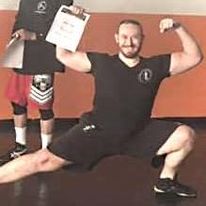
Hi, my name is Solomon Blake. The keeper of the Ginger Magic, The Infinite Sol Daddy, The Goddamned Orangutrain. I’m not very formal, and you don’t have to call me Sifu or Coach. That’s up to you. I grew up in the 1980s and ’90s, and that’s what got me into martial arts. It was a golden era of action movies and cartoons, we saw the boom of fighting video games, and the birth of the UFC. I was enamored with He-Man, Van Damme, Power Rangers, and Jackie Chan; Dragon Ball Z and WWE (though back then it was the WWF). One of my early memories is putting on my white long johns as though it was a karate gi, and playing like I was Chuck Norris. Before I started my formal training, I remember mimicking every move I could. I wanted to be a hero. I wanted to do karate, swing swords and shoot guns. Then, in 1995, my dad was pulling his hair out trying to get my brother and I into something athletic. We hated everything, and then he enrolled us in Kenpo Karate, and it clicked. That was the beginning of becoming a professional martial artist.
My Chinese Karate – An Essay
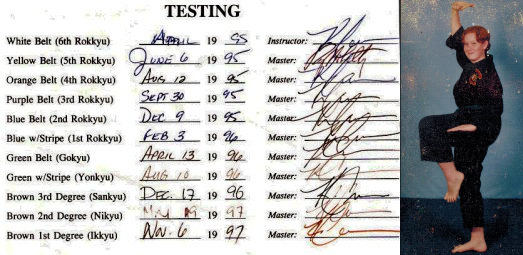
I began my martial arts journey formally in 1995 (I was a pretty good JCVD mimic before that, if I do say so myself!) I remember my dad telling me in no uncertain terms that I was getting fat, and that was unacceptable. You see, my dad played sports growing up, so he put me in just about every sport in school, including wrestling, and I didn’t like a single one of them. I stuck with baseball the longest, and that was just a couple of years, and I washed out of that too. Sports just weren’t my thing. And Dad noticed that I really like action movies and tv, so he thought he’d try martial arts, and that’s what stuck. We visited a couple of dojos, and I remember him saying that after looking around and doing some research, this local school seemed like it was the best option. Whether it was or not, it’s where I got my start. That school was Masters Self Defense in Dover, NH. The style was Shaolin Kenpo Karate. Sensei Kevin Crossan and his wife Lisa were my teachers.
I fell in love with Kenpo Karate. It was karate like they did in Power Rangers, and like Van Damme Did in the movies. It was exactly what I wanted. What I didn’t know at the time was how crazy the world of Kenpo was. Why do I always get involved in arts with fuzzy history and controversy???
What is Kenpo?
I’m going to try to keep this short. Kenpo is the Japanese pronunciation of 拳法, or quan fa (pronounced ch’üan fa) in Mandarin or kyun faat in Cantonese. It translates literally as “fist method” (or law, but it should NEVER be translated as “law of the fist” that’s some try-hard bullshit, and just isn’t accurate.) The term was common in China, and the English there tended to translate it more as “Chinese boxing”. Chinese Boxing was never a specific style, but rather a categorical label of Chinese Martial Arts that focused on fist fighting rather than grappling, though grappling remained a part of most Chinese Boxing styles, even if only minor. Keep in mind up until 1867 and the adoption of the Queensbury rules of boxing, boxing included stand up grappling, a feature of all traditional striking martial arts. Chinese Boxing, and most pre-20th century fist fighting systems, involved a mix of striking, holding, and throwing. In Chinese these are referred to as Da, Ti, Na, Shuai (romanized from Mandarin). 打 Da: Striking; 踢 Ti: Kicking; 拿 Na: Holding; 摔 Shuai: Throwing.
In Japan, and Japanese speaking countries, they tend to refer to Chinese martial arts in blanket fashion as kenpo similar to how we say kung fu here in the west. Several karate schools in japan recognize their Chinese roots, and referred to their style as kenpo instead of karate, such as the notable Motobu Kenpo school. There is a separate school called Shorinji Kenpo and is a completely separate school of martial arts from other karate styles, and should not be confused as the same.
OK, so kenpo is just the Japanese way of saying kung fu, and several karate schools have used the term. From there we need to export to the United States, where we meet James Mitose.
Enter: Mitose
James Mitose was born in Hawaii to a Japanese family. He was sent to japan for his education, where he learned martial arts. His lineage is dubious to say the least. I won’t rehash the story, but he claimed to have learned a distinctly Japanese martial art called Kenpo in a temple in Japan. His book What Is Self Defense? seems to have heavily leaned on another book, Karate Kenpo by Mutsu Mizuho. He seems to have put Motobu Choki in a place of prominence that suggests he was his teacher. And much like Choki, he is said to have taught Naihanchi as the only kata in his school.
Now, having an unclear lineage does not invalidate the martial artist, it just means to have judge the individual independent of his lineage, Which is honestly not a bad thing. And let me be clear, dubious just means uncertain, not shady. Nevertheless, he ended up with some serious students, and eventually settled on the name Kosho Shorei Ryu Kenpo for his school. His student Bruce Juchnik is, perhaps, the most notable still practicing Kosho Ryu. But the most famous is William Chow.
When James Mitose met William Chow is kind of where Kenpo really took off in the USA.
Enter: William Chow
William Chow is another whose story is highly contended. Did his family practice kung fu or not? How much formal training did he have? Some say he was a student of Mitose, others say they were training partners engaged in a knowledge trade. I don’t know, and they’re both dead, and it honestly doesn’t matter because what we have is what we have.
What we do know about Chow is that he liked to scrap. He was known for challenging servicemen to street fights, and somehow never got in legal trouble for it. Over his lifetime, he trained several notable people, perhaps most famous are Adriano Emperado and Ed Parker. The former creating Kajukenbo, and the latter creating American Kenpo. Chow settled on the name Kara-Ho Kempo for his school. He is said to have not practiced many kata/forms, but encouraged his students to learn or create their own.
From Kajukenbo to Shaolin Kenpo Karate
Adriano Emperado branched off of Chow’s Kenpo with his own blend of Karate, Judo/Jujutsu, Kenpo, and Chinese Boxing (Ka-Ju-Ken-Bo) and he kept up the culture of testing the art in street fights. It was a real fight club style art. One of his students, Sonny Gascon, had learned some martial arts with his family, and in the military, and found a home in Kajukenbo when he was stationed in Hawaii. He later moved to California, and he left the Kajukenbo organization for financial/political reasons, and named his school Karazenpo Go Shinjutsu. Karazenpo is a portmanteu of Karate, Zen buddhism and Kenpo (Kara-Zen-Po). Go Shinjutsu (properly goshin-jutsu) means “Self Defense Art”.
Gascon created the numbered kata and self defense combinations standard to much of the kenpo world, especially in the east coast lineage I come from. It was his student George Pesare, and Pesare’s student Nick Cerio who shaped what would become Shaolin Kenpo Karate.
East Coast Kenpo
We start with George Pesare, from Rhode Island, who joined the military, ended up in California, and trained under Gascon and his student Joe Blacquerra. Over his life time, he was awarded black belts in not only Karazenpo Go Shinjutsu, but Judo, Taekwondo, Aikido, and Eskrima (very few Eskrima schools use belt ranking, and I have no info on who he trained with). Pesare moved back to Rhode Island, and called his style Kenpo Karate, and kenpo became an east coast phenomenon. His most notable student was Nick Cerio.
Nick Cerio, another military man and perennial student of the martial arts started off in boxing, and then judo in the air force, from there earning rank in kenpo (still Karazenpo Go Shinjutsu at the time) under Pesare, as well as hakkoryu jujutsu, kobudo, and Sil Lum Kung Fu. Professor Cerio retooled the system and put his own thumbprint on it, adding in his other studies and understanding. Under Professor Cerio we get the highly controversial figure of Fred Villari.
I’m not going to speak much of Villari other than his mix of arts that he learned on top of Nick Cerio’s Kenpo, mainly kung fu and karate styles, though he claims some grappling as well, gave us what he called Shaolin Kenpo Karate. His students Robert Nohelty and James Bryant broke off to found Masters Self Defense Centers where kept the name Shaolin Kenpo Karate, but essentially scrubbed all mention of Villari. Nohelty and Bryant went on to earn rank under Cerio and Pesare, and Fred Villari is not given credit for anything.

My teacher, Sensei Kevin Crossan, learned from Nohelty and Bryant, as well as having rank in American Kenpo Karate, and was actively training at the Boston Kung Fu Tai Chi Institute under Joshua Grant and Yao Li. He eventually broke our school off of the Masters Self Defense organization, and we went independent.
That’s where we get to me. Just some kid living in southern Maine, training in New Hampshire, oblivious to the insanity of the Kenpo world. To me, I was just learning “karate”. Everything was karate back in the 90s. It had brand recognition, and was easier to sell to the soccer moms and accountant dads who were paying for their kids’ lessons.
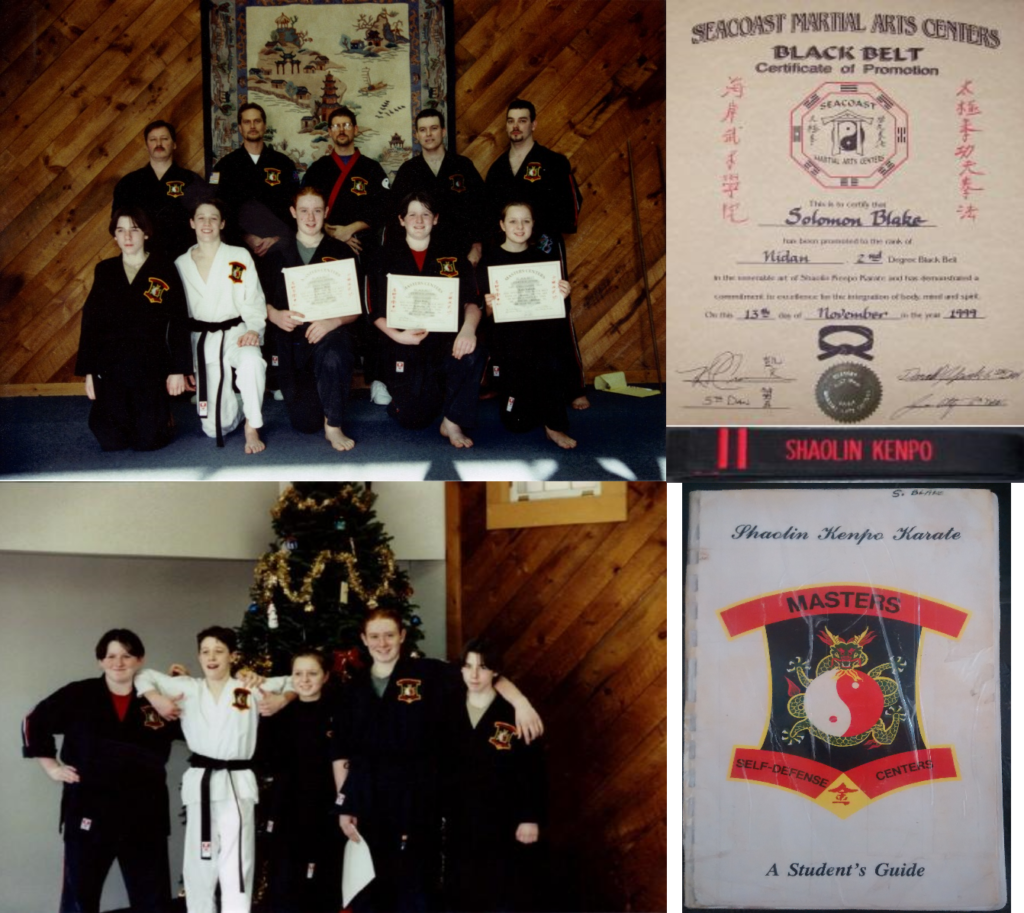
What is Kenpo to me now?
I spent about 9 years in Kenpo Karate. Two schools (a third one later, very briefly), and two different lineages (and that later third…), earning 3rd brown (1st kyu) in American Kenpo (AKKS), and spending a short amount of time in a Chinese Kenpo school, going through purple belt before I got sick of the instructor’s lies and half truths, and constant bragging.
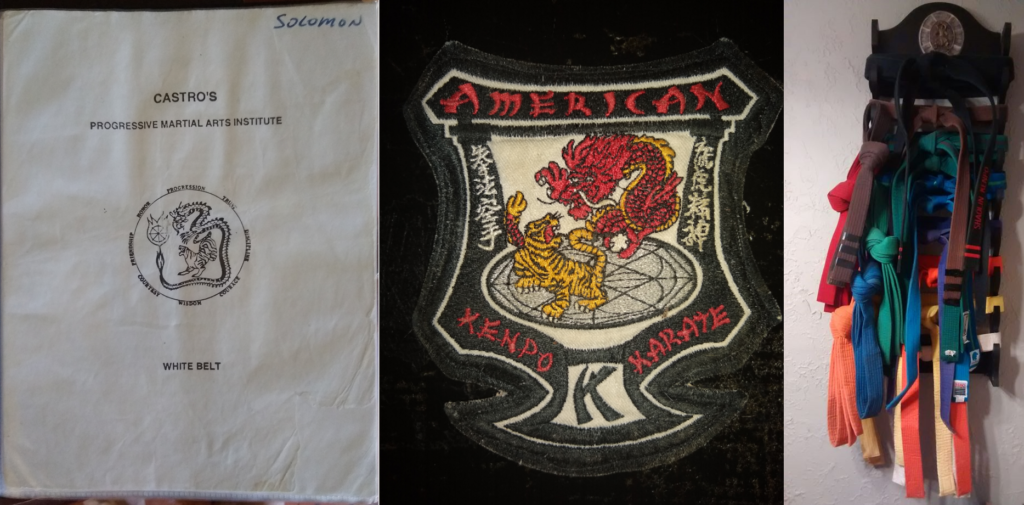
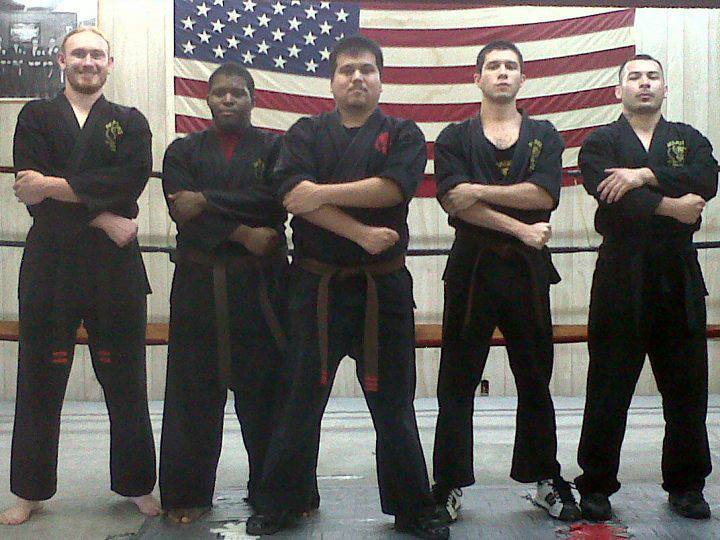
I was allowed to wear my 2nd Dan belt despite only being a purple belt in this lineage.
Kenpo, in America, is an insane culture originally based on little more than street fighting and traditional martial arts of dubious origin. A lot of the forms, one steps, and drills are original and unique to Kenpo. Kenpo is all at once, Karate, Kung Fu, Street Fighting, and Individual Tailoring. It is American Chinese-Karate. But more than that, it’s just Kenpo.
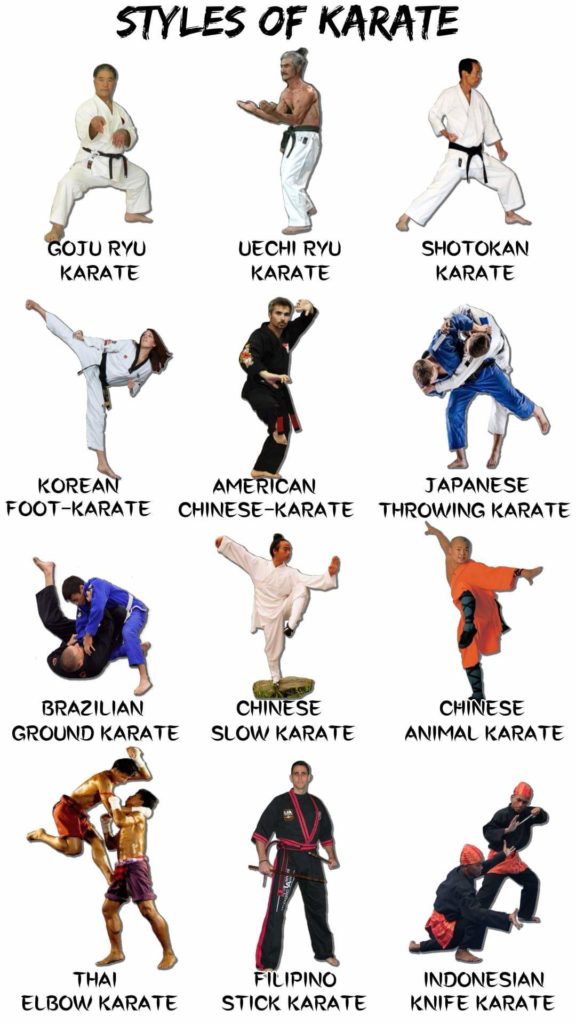

Kenpo will always be a part of who I am, and it’s a toolbox that makes sense to me, but since those days, finding my center in Wing Chun, competing in amateur MMA, learning Catch Wrestling and Fencing, Kenpo is now just the graded earth underneath the foundation. I don’t teach the curriculum, but Kenpo makes its way into every class I teach. My Kenpo is freestyle now, or perhaps the better term is san shou.
散手 San Shou (Mandarin. San Sau in Cantonese) essentially means sparring. It translates as “free hand” (san can also translates as scatter/disperse) and can be seen somewhat analogous to randori in judo. Before the formalized sport of Sanda was born, there were multi-style martial arts academies in China, and they had lei tai matches which were essentially kung fu vale tudo. San Shou was a term adopted for mixed style sparring and fighting. And I can’t think of a more appropriate term for how Kenpo figures into our specific mix. So despite the face that Kenpo is a Japanese term, and san shou is a Chinese term, Kenpo San Shou 拳法散手 has a nice ring to it, or to be grammatically consistent: Freestyle Kenpo.
Going from Kenpo to MMA
I was fortunate in the fact that the Kenpo schools I trained at were multi-disciplinary schools. So not only growing up with a taste for several arts, but having my early experience spread across influences helped keep my mind open and away from dogma. In the Shaolin Kenpo school cross trained us in wushu once a week during the last year I was there. I wasn’t able to go to the tai chi classes because they happened while I was in school, but my dad went to them, and I just attended the seminars when Sensei would bring his Sifu to the school.
At the American Kenpo school I attended next, we split our time nearly 50/50 from the Kenpo with Kickboxing and Conditioning classes based mostly in Savate, with some influence from Filipino boxing and even the tiniest taste of Thai kicking. It turns out that Sifu Castro was also a Dan Inosanto student (originally a Kenpo guy before Bruce Lee!) And thorough that connection, we got a lot of Guru Inosanto’s material mixed in with our kickboxing. Since then I have found many I train with to be connected to Inosanto in some way. Sifu Castro even showed us some basic grappling and FMA when he could slide it into class. It wasn’t a major part, but it was an introduction.
So when I moved away to get married and start adult life, I found myself in a town with no martial arts schools. For the next 6 years my training was independent. I would grab people from work to train with, plenty of solo training, and I found a gold mine in the local university. Prior to quitting school, I met an army guy named Sean Menard who was teaching MMA after classes. He was primarily teaching Boxing for mma, with a touch of thai kicking, and wrestling with some additional grappling from SAMBO (we never wore the jacket) I trained with him for a couple of months until I broke a rib (my own stupid fault) and by the time I was ready to train again, he had moved on to a career, and was no longer teaching. So back to training with whoever I could grab.
Eventually, I met another army guy who wanted to start a club, so we did. We just used the college student athletic center since he was enrolled there, and we started training harder than I’d ever trained in my life. We kept finding new guys to come train, and we just shared knowledge, and trained 5 days a week, 3+ hours a day. We found fights to take, won some, lost some, trained harder. We had so many influences coming in, jiu-jitsu, lots and lots of wrestling, boxing, taekwondo, karate, muay thai, even a touch of kuk sool won (we didn’t spend much time on that…) Some of us even went beyond mma, and trained firearms and other weapons with our Army Ranger pal. Then it was time to move again, my wife and I set our sights on Arizona, but I have never forgotten that chaotic 6 years of independent, informal, knowledege-trade, obsessive hard work. It shaped who I am, and gave me the tools necessary to continue my journey as I have. It was my first real exposure to coaching, full contact fighting, and cemented the anti-dogma attitude.
My French Kung Fu – An Essay
I mentioned Savate. This is my French Kung Fu. Alongside my understanding of parkour from the couple of years I spent practicing that after I moved to Phoenix. Parkour is, of course, not a martial art, not in the traditional sense. However, it is connected to martial arts culture, and is a fantastic companion to martial arts. In Julie Angel’s book Breaking the Jump, she mentions that the guys in France who started the whole movement were big fans of martial arts action, and essentially wanted to do the stuff Jackie Chan was doing (and more!) And for me, I found my parkour coach because I wanted to do Jackie Chan and Batman stuff! It’s a really interesting book, and I definitely recommend it.
Getting back to the Savate, while I was under Sifu Castro, our kickboxing classes, and our sparring in general was based in Savate. He learned under Professor Salem Assli through his connection with Dan Inosanto. So we were primarily using the modern evolution of the sport. It was my introduction to western boxing, which would later get fleshed out training with boxers for MMA.
Let’s take a moment to talk about Professor Salem (R.I.P.) He’s such an interesting connection to Savate. Salem Assli was a big fan of Bruce Lee, and he wanted to learn Jeet Kune Do. So he moved here from France and found Guru Dan Inosanto. Guru Dan, reportedly, asks him if he knows anything about Savate. When he says, “No,” Inosanto hands him a book and tells him to learn it. So he starts learning and working with a group of Inosanto’s students on it. Professor Salem then decided to legitimize himself, goes back to Franch, takes the official exam, passes with flying colors, takes a couple of fights to cement it in, and then takes the instructor exam, and passes that as well. He goes back to the Inosanto Academy, and stayed a fixture in the community until his passing in 2021. And because of him, Savate became a part of my journey through our connection with Dan Inosanto through Sifu Castro.
Of course, Savate is known for its kicking. The story goes that striking someone with a closed fist was considered assault with a deadly weapon back in 1700s France, but apparently open handed strikes, wrestling, and kicking were still on the table. To make a long story short, Savate was a sort of street fighting that developed during a major population boom, getting its name (translated as “Old Shoe”) from the boots the soldiers coming home from war wore. The brutal street fighting art was marked by low kicks with those hard shoes. At the same time, down in Marseille, the sailors were playing a game known as chausson (“slipper”) where they worse soft shoes, and practiced kicking each other, as you do, and those chaps are where we got the high kicks from. By the time you get to the late 1800s, Joseph Charlemont was leading the charge combining these two French arts with English boxing, and Cane Fighting, which was based on military sabre fencing.
Bareknuckle HEMA
In 2016, I had found a HEMA club to start learning proper historical fencing, and through them I found out how to start finding the old source material. It turns out there are many old Savate books, and I began digging into the historical methods that have been left behind by the modern sport, bringing it back to its bareknuckle roots, putting the throws back in (yes, they practiced throwing in Savate!) learning the cane, and digging into the old bareknuckle English boxing. This return to the old form invigorated my modern base, and made it feel more alive, and brought it into focus within the larger MMA picture better than ever.
At this point, I had also found my Catch Wrestling coach, and started finding old Catch manuals as well. Adding to this some of the other historical grappling found throughout many manuals, I started to formulate a Historical European Mixed Martial Arts (HEMMA) concept, or, as I like to think about it, “what if Batman was a HEMA guy?” Even with the Parkour, if you go through some HEMA sources, we find some sparse references to exercise and tumbling and early gymnastics, making for even a historical approach to environmental movement and conditioning. So while I don’t teach it as a separate curriculum, I consider this practice as Bareknuckle HEMA, and it makes for a fun way to mix up training from time to time.
Kickboxing and Super Hero School
The lessons from Savate, both modern and historical, and the pursuit of becoming like Jackie Chan and Batman leading me to Parkour has become a sort of French Kung Fu for me. And yes, we just integrate these things into our overall curriculum of kickboxing, MMA, environmental movement, and conditioning, but they remain a strong influence, and a point of continued study. Because it seems that no matter how old I get, I still just want to be a super hero, and do super hero things. It’s what got me into martial arts, and the benefits of that journey are what have kept me here.
Catching Up To The Present
I’m not going to spend as much time on this section, since it’s largely what we’re doing now. In 2011, a friend from the 3rd Kenpo school I trained at recommended I check out a local Wing Chun class. Wing Chun wasn’t really on my radar. I’d heard of it, and seen some, but I had my heart pretty well set on MMA. But I couldn’t afford to go to an MMA gym, and I could absolutely manage the Wing Chun school, so I figured I’d try it. Literally, no joke, my first class made me feel like it was exactly what I had been missing. So I stayed. I had no idea it would become my core style, just that it completed a missing piece of the puzzle for me. Around the time I had earned my instructor certificate, one of my kung fu brothers, who was also a Dan Inosanto student, recommended I check out a Catch Wrestling seminar since he knew about my MMA background. Much like Wing Chun, I’d heard of it, seen a little, but it wasn’t really on my radar. So I go, and the same exact thing happened. Everything clicked, and I had found my grappling style. I’ve been with Coach John since. Then around 2017 I had been looking into more weapons training. I was seriously considering Filipino Martial Arts since I’d had some exposure, my Sifu had been doing FMA, and a lot of Wing Chun guys go to FMA because of our twin knives. However, I’d started digging into the HEMA world, and found a club about a mile from my house. I had no reason not to go, and again, I haven’t looked back since. We briefly roomed with the HEMA club, but a fire sent us our separate ways. I have continued to study HEMA, and we’ve made friends with a couple other sword fighting clubs since. And that pretty much brings us up to present. This is my martial arts journey, and who knows what the next 20 years will bring? I’m not going to stop, and I’d love for you to join me on my journey.